![]()
![]()
![]()
Use LEFT and RIGHT arrow keys to navigate between flashcards;
Use UP and DOWN arrow keys to flip the card;
H to show hint;
A reads text to speech;
46 Cards in this Set
- Front
- Back
|
Variation |
Differences between different species and also in the same species A result of mutation For the process of natural selection and therefore evolution Can be as a result of environmental variation or genetic variation or both Genotype - genetic makeup of an organism Phenotype - visible characteristics of an organism |
|
|
Chlorosis |
Plants genetically coded to produce large quantities of chlorophyll, green pigment vital for photosynthesis Chlorosis where pale and yellow leaves as not producing the normal amount of chlorophyll Reduce ability of the plant to make food by photosynthesis Most plants with chlorosis have normal genes coding for chlorophyll production so change of their phenotype from environmental factors Lack of light Mineral deficiencies - lack of iron or magnesium such as cofactor for some enzymes that make chlorophyll Virus infections - viruses in plants interfere with the metabolism of cells so no longer support the synthesis of chlorophyll Can be genetic, environmental or both |
|
|
Animal body mass |
Within a species, the body mass individual animals vary Both genetic and environmental factors Amount and quantity of foods eaten, the quantity of exercise or the presence of a disease are environmental factors Cause significant health problems Obesity can also be a result of genetic make-up of an organism such as from a mutation of chromosome 7 in mice |
|
|
Creating genetic variation |
From the alleles inherited from your parents Alleles inherited influence characteristics displayed Genetic variation from sexual reproduction as crossing over and independent assortment of genes in meiosis and random fusion of gametes Only mutations in the gametes can be passed on to the offspring Mutations give new alleles and variation Mutations from physical agents (X-rays), chemical agents (mustard gas, tobacco smoke chemicals) or biological agents (some viruses, food contaminants) Mutation may be harmful, advantageous or neutral |
|
|
Dominant and recessive |
Dominant allele is the version of the gene that will always be expressed if present in an organism Recessive allele is the version of the gene that will only be expressed if 2 copies of the allele are present Homozygous - have two identical allele for a characteristic so can be homozygous recessive or homozygous dominant Heterozygous - have two different alleles for a characteristic so the dominant is expressed |
|
|
Continuous variation |
Continuous variation Definition - A characteristic that can take any value within a range so has 2 extremes Cause of variation - Genetic and environmental Genetic control - Polygenes - controlled by a number of genes Examples - Leaf surface area, animal mass, skin colour |
|
|
Discontinuous variation |
Definition - A characteristic that can only appear in specific discrete values Cause of variation - Mostly genetic Genetic control - One or two genes Examples - Blood group, albinism, round and wrinkled pea shape |
|
|
Monogenic inheritance |
Show how genes are passed on from one generation to the next In a genetic gross punnett square Such as Mendel and green/yellow and round/wrinkled peas |
|
|
Performing a genetic cross |
State the phenotypes of both parents State the genotypes of both parents - a capital letter represents the dominant allele and a lower case letter represents a recessive allele such as Bb State the gametes in a circle Use a punnett square to show the results of random fusion of gametes during fertilisation State the proportion of each genotype which are produced as a percentage or ratio State the corresponding phenotypes for the offspring |
|
|
Punnett square |

|
|
|
Codominance |
When two different alleles occur for a gene and are both equally dominant Both alleles are expressed in the phenotype of an organism if present Such as snapdragon flowers where codominant red and white flowers The red codes for an enzyme that catalyses the production of the red pigment from the colourless precursor and the white is an altered version of the enzyme that doesn’t catalyse formation of pigment Red flowers = homozygous for red allele White flowers = homozygous for no pigment allele Pink flowers = heterozygous to produce enough pigment for pink Such different letters in codominance as superscript such as CR and Cw |
|
|
Codominance punnett square |
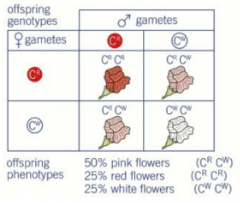
|
|
|
Multiple alleles |
Some genes have more than two versions so have multiple alleles An organism still only carries two versions of the same gene - one on each homologous chromosome Such as blood group where codes for different antigens on the surface of red blood cells IA - antigen A, IB - antigen B, IO - neither antigen IA and IB are codominant and are both dominant to IO Blood group A - IAIA or IAIO Blood group B - IBIB or IBIO Blood group AB - IAIB Blood group O - IOIO |
|
|
Sex linkage |
Characteristics that are determined by genes on the sex chromosomes are called sex linked Male is XY and female is XX The Y chromosome is very small so contains almost no genetic information so males only have one allele on the X and none on the Y So males more likely to show recessive as only need one if on X but not on Y Females less likely as need two recessive with one on each X |
|
|
Haemophilia |
A sex-linked genetic disorder where blood clots very slowly due to absence of a protein blood-clotting factor so prolonged bleeding Majority of sufferers are male as only females can be carriers In a cross show X and Y with X having a superscript dominant or recessive allele depending on the case such as XH and Xh |
|
|
Haemophilia punnet square |
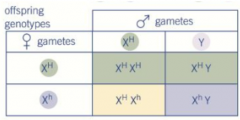
|
|
|
Dihybrid cross |
The inheritance of two different characteristics, caused by two genes that may be on different pairs of homologous chromosomes and each gene can have two or more alleles Each parent has 4 alleles and 4 gamete combinations Each as in pea plants from yellow/green (Y/y) and round/wrinkled (Rr) Produces 16 different combinations |
|
|
Dihybrid punnett square |
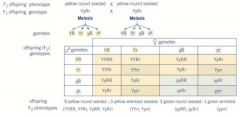
|
|
|
Why different ratio than expected |
Fertilisation of gametes is a random process so in a small sample a few chance events can lead to a different ratio If both on same chromosome then linked and may be inherited together |
|
|
Linkage |
Observed ratios from dihybrid are different from what expected Linkage distorts ratio as genes located in the same chromosome When not on sex chromosomes it is autosomal linkage Linked genes are inherited together as no independent assortment during meiosis unless the alleles are separated by chiasmata Can’t undergo the normal random shuffling of alleles during meiosis Such as body colour and wing length in fruit flies The offspring normally have the same characteristics as the parents and the few different from the parents are called recombinant offsprings The closer the genes are on the chromosome, the less likely that they are to be separated during crossing over so even fewer recombinant offspring produced |
|
|
Recombination frequency |
Recombination frequency is a measure if the amount of crossing over that has happened in meiosis Recombinant frequency = number of recombinant offspring / total number of offspring 50% recombinant frequency indicates no linkage and the genes are in separate chromosomes Less than 50% indicates there is gene linkage so not random process of crossing over Determined by how close the genes are on a chromosome The closer they are the less likely they will be separated during crossing over |
|
|
Chi-squared test |
Observed results will normally differ from expected results Create a null hypothesis to be disproved Compare to data to find critical value of X2 with 5% significance and if less then no significant different and if greater than the critical value then a significant difference |
|
|
Chi-squared test calculation |

|
|
|
Epistatsis |
The interaction of genes at different loci Gene regulation is a form of epistasis with regulatory genes controlling activity of structural genes in the lac operon In a biochemical pathway involving genes for enzymes then if one isn’t present then the other steps won’t work either so not expected characteristic As lack of substrate for the next enzyme The genes are masked by the lack of expression of the previous gene If for colour then expected colour isn’t produced and often the colour of the precursor not a pigment A gene affected by another gene is hypostatic A gene that affects the expression of another gene is epistatic |
|
|
Dominant and recessive epistasis |
An epistatic gene may influence the activity of other genes as a result of the presence of dominant or recessive alleles If two recessive alleles at a gene locus led to the lack of enzyme then it is recessive epistasis Dominant epistasis occurs if a dominant allele results in a gene having an effect on another gene If an epistatic gene that isn’t in the pathway coded for an enzyme that modified one of the precursor molecules in the pathway so the next enzyme doesn’t have suitable substrate so the pigment isn’t produced as the sequence is masked |
|
|
Labrador colours |
Result of pigment melanin being deposited in the skin and fur One gene coded for pigment production with black B and brown b A second gene codes for where the pigment is deposited and has 2 alleles skin and fur E and skin only e Epistasis E locus epistatic and masks hypostatic B |
|
|
Population genetics |
Investigates how allele frequencies within a population change overtime Sum total of genes in a population is the gene pool Frequency that an allele occurs is not linked to whether it is dominant or recessive Can change over time in response to changing conditions Evolution involves long-term change in allele frequencies |
|
|
Hardy-Weinberg principle |
Frequency of alleles always adds to 1 p+q=1 Mathematical relationship between allele frequencies and genotype in a stable population that isn’t evolving States that in a stable population with no disturbing factors, the allele frequencies will remain constant form one generation to the next and there will be no evolution Allows a measure and study of evolutionary changes when they occur p2 + 2pq + q2 =1 p2 = frequency of homozygous dominant genotype 2pq = frequency of heterozygous genotype q2 = frequency of homozygous recessive genotype |
|
|
Light = recessive Dark = dominant 48 out of 50 are light |
48/50 = 0.96 q = √0.96 = 0.98 p+q =1 so 1-q= p 1-0.98 = 0.02 =p Frequency of homozygous dominant = p2 = 0.022 = 0.0004 = 0.04% Frequency of heterozygous = 2pq = 2 x 0.02 x 0.98 = 0.039 = 3.9% |
|
|
Limitations of Hardy-Weinberg principle |
Assumes a theoretical breeding population of diploid organisms that is large and isolated With random mating, no mutations and no selection pressure but these conditions don’t occur in the natural environment |
|
|
Factors affecting evolution |
Mutation - existence of new alleles leading to genetic variation Sexual selection leads to an increase in frequency of alleles which code for characteristic that improve mating success Gene flow - movement of alleles between populations from migration for different allele frequencies Genetic drift in small or isolated populations - a change in allele frequency due to the random nature of mutation. A new allele in a small population will have a greater impact Natural selection leads to an increase in the number of individuals what have a characteristic that improves their chance of survival so their reproduction rates of the individual increases to pass on the advantageous allele |
|
|
The impact of small populations and factors affecting population |
Small populations have low genetic diversity leading to variation
Lack of variation means can’t adapt to change so easily as large populations so more likely to become extinct
Factors which limit the size of population
Density-dependent factors - competition, predation, parasitism and disease
Density-independent factors affect populations of all sizes - climate change, natural disasters, seasonal change, human activity |
|
|
Population bottlenecks |
Large reductions in population which last for at least a generation are called population bottlenecks Greatly reduce gene pool and genetic diversity Such as a natural disaster or epidemic resulting in only a few surviving so all future variation and alleles form only a small group so inbreeding such as in cheetahs Takes 1000s of years to recover to accumulate mutation again |
|
|
Founder effect |
Small populations can arise due to the establishment of new colonies by a few isolated individuals Extreme example of genetic drift These small populations have a smaller gene pool and smaller genetic variation Have different allele frequencies than the large population such as large amount of recessive so larger impacts from natural selection Subject to random genetic drift Such as colonising an island with the main population on land |
|
|
Stabilising selection |
Variation shown on a normal distribution curve with the most popular in the middle and few extremes The extreme characteristics reduce the chance of survival so less likely to survive and pass on genes Reduction in the amount of variation as more are the average which is selected for Increase in average alleles Such as human birth weights |
|
|
Stabilising selection diagram |
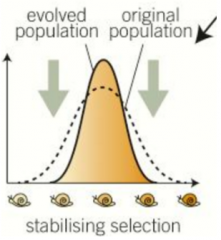
|
|
|
Directional selection |
Change in selection so the norm is no longer the most advantageous Organisms at one end of the extreme are selected and pass on their alleles so the number of the extreme increase and the original average decreases Such as peppered moths in the industrial revolution Evolution occurs |
|
|
Directional selection diagram |
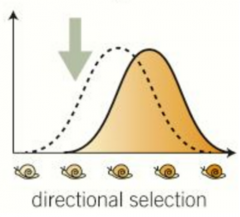
|
|
|
Disruptive selection |
Both extremes are selected for and the norm is selected against When environmental conditions are varied Bell shaped curve has 2 peaks Diversifying selection |
|
|
Disruptive selection diagram |
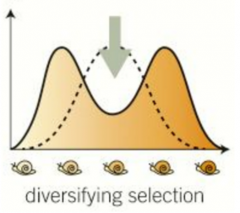
|
|
|
Speciation |
The formation of a new species through the process of evolution No longer able to interbreed to produce a fertile offspring with the original species Members of the population become isolated and no longer interbreed so no gene flow between the two populations Alleles within the group continue to undergo random mutations The accumulation of mutations and changes in allele frequencies over many generations lead to large changes in the phenotype |
|
|
Allopatric speciation |
The more common from of speciation When some members of a population are separated by the rest of the group by a physical barrier such as a river or mountain so they are geographically isolated The environments in the two different areas will be different so adapt to different selection pressures Often result in the founder effect Such as different finches on different islands in the Galapagos for different food on different islandsBarrier prevents gene flow Mutations accumulate so no longer interbreed as biochemistry/behaviour/DNA changed too much Reproductively isolated new species |
|
|
Sympatric speciation |
Occurs in populations that share the same habitat Happens less frequently and mainly in plants than animals In plants when two members of different species produce a fertile offspring that has a different number of chromosomes and is polyploidy so has double the amount of chromosomes. The hybrid is reproductively isolated Such as modern wheat that has had 2 hybridisation events and is a hexaploid Rare in animals but blind mole rats only mate with other individuals that share the same soil type as them so lack of gene flow and forms two different species |
|
|
Artificial selection |
Populations are usually polymorphic (more than one distinct phenotype) for more characteristics Artificial selection the same as natural selection but the selection pressure is applied Instead of environmental pressures, humans select the desirable characteristic Individuals with the desired characteristic are selected and interbred The offspring of this cross are then selected and bred again Inbreeding as closely related individuals Results in changes in the frequency of alleles and eventually speciation |
|
|
Problems with inbreeding |
Limiting the gene pool so decrease genetic diversity Many genetic disorders in the population Over time reduces the ability of the population to survive and reproduce |
|
|
Gene banks |
Seed banks keep samples of seeds form wild and domesticated varieties Also sperm and egg banks Used to increase genetic diversity after inbreeding in process called outbreeding Increases potential to adapt to environmental change |

